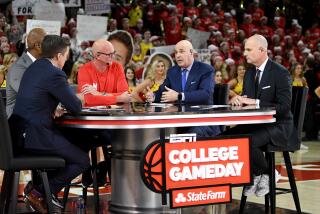Cable TV firms, Sony end dispute
- Share via
WASHINGTON — More interactive TV soon could come your way, after Sony Electronics Inc. and top U.S. cable TV providers said Tuesday that they had resolved a technology dispute.
Analysts and industry representatives hailed the deal as a breakthrough in the quest to offer TV viewers more Web-like interactivity, in many cases without the need for those bulky cable set-top boxes and remote controls.
The agreement could lead to a slew of new interactive services, such as personalized programming guides, customized news and sports tickers, live on-screen chats during TV shows and far more video-on-demand options.
Sony plans to incorporate the cable industry’s interactive technology, called tru2way, into TVs that will enable people to plug the cable directly into the back of the set. Sony had been a major proponent of a competing interactive, plug-and-play technology known as DCR Plus.
With Sony on board, other manufacturers are expected to sign similar agreements with the six largest cable TV companies, including Comcast Corp., Time Warner Cable Inc., Cox Communications Inc. and Charter Communications Inc. The deal also could keep the Federal Communications Commission from stepping in to resolve the dispute.
“We are pleased that this technical challenge has been addressed through a voluntary, private-sector solution,” said Gary Shapiro, president of the Consumer Electronics Assn., which represents leading manufacturers. FCC officials declined to comment.
Lawmakers and regulators have been trying to free consumers from cable set-top boxes since 1996. Although some programming can be viewed by plugging a cable line directly into the TV, premium and digital channels require boxes to convert the signals.
Cable companies have developed special cards to insert into newer TVs to eliminate the need for the boxes, but the cards have been plagued by problems and don’t allow for two-way communication that enables viewers to order movies and send other data requests to the cable companies rather than passively receive programming.
The cable industry and consumer electronics manufacturers couldn’t agree on a standard for two-way, plug-and-play TV sets and other devices, such as digital video recorders. After pushing DCR Plus, Sony decided to sign on with cable’s technology.
Richard Doherty, research director for Envisioneering Group, a technology assessment and market research consulting firm, said Sony realized that the majority of TV viewers have cable and that the company had to cut a deal as pressure mounted to compete with interactive Internet content.
“Cable is still the big dog . . . and they want to make sure a Sony TV is at the end of that cable,” he said.
Sony, in a statement, called the deal “good news for consumers.” The company did not explain why, and a Sony spokesman could not be reached for comment.
Some TV manufacturers already have licensed the tru2way technology and have been developing new products. But Sony’s agreement with the cable companies is more comprehensive, said Kyle McSlarrow, president of the National Cable and Telecommunications Assn., which represents cable providers and programmers.
McSlarrow said the agreement resolved a “chicken-and-egg” problem: Cable companies didn’t want to upgrade their networks for interactive services until manufacturers committed to make two-way products, while manufacturers didn’t want to make the products until the cable companies promised to make the services available.
To help address the issue, cable companies agreed to put two-way technology in at least 20% of their set-top boxes, a recognition that many consumers will not upgrade to plug-and-play sets for years.
“This is a complete answer to the question of how you bring an interactive, two-way, plug-and-play TV to market,” McSlarrow said.
--
More to Read
The biggest entertainment stories
Get our big stories about Hollywood, film, television, music, arts, culture and more right in your inbox as soon as they publish.
You may occasionally receive promotional content from the Los Angeles Times.











